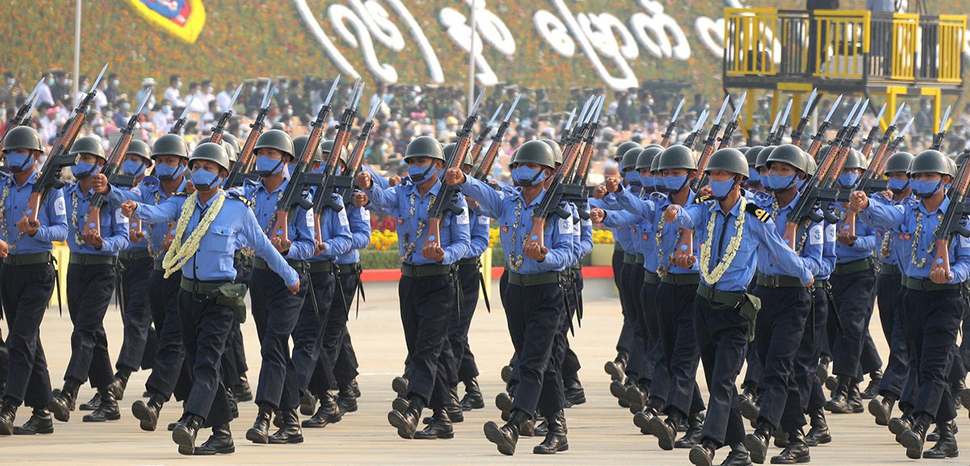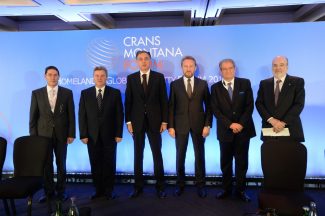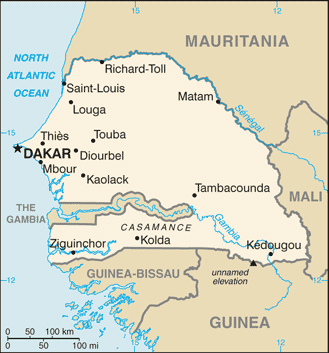The Myanmar civil war can be traced back to 1948, when the Karen National Union (KNU) emerged as the first ethnic armed organization (EAO) to deploy on the battlefield. With Burma comprising 135 ethnic groups, numerous armed factions have arisen since then, often accompanied by corresponding political wings. Some groups dissolved, rebranded, and reentered the fray. Presently, over 25 armed factions operate, with most opposing the government, and some aligning with it, and others observing a ceasefire. Despite repeated attempts by the government to secure a Nationwide Ceasefire Agreement (NCA) with resistance armies, many have refused. Some initially signed the NCA but resumed hostilities against the Tatmadaw following the 2021 coup.
The ongoing conflict, characterized by its smoldering, low-intensity nature, occasionally escalates into more intense bouts of fighting before subsiding. However, since the 2021 coup, reported clashes have surged by about 67%. The ‘1027 Offensive,’ launched by the Three Brotherhood Alliance last October, appears to signal a significant shift in the conflict, with resistance forces securing substantial territorial gains and achieving numerous victories. This success has also emboldened other ethnic armed groups (EAO) to join the alliance.
Since the coup, several new EAOs and militias have emerged or reactivated, with many rallying under the National Unity Government (NUG). Comprising lawmakers elected in the 2020 election, the NUG aims to consolidate command over diverse EAOs to counter the Tatmadaw. Its military arm, the People’s Defense Forces (PDF), strives to unify all autonomous PDFs under a single command structure. While tensions persist among some EAOs, the NUG, and PDF, most disputes are set aside to facilitate collective efforts aimed at ending the military dictatorship.
Below is a comprehensive and up-to-date list of current armed groups and political parties, along with brief explanations of their backgrounds and activities. It’s important to note that the fluid nature of conflicts in certain regions means that new groups can form, existing ones may splinter, and alliances can shift over time. While this list provides an overview of the current landscape, the situation on any given day may vary.
Armed Groups and Political Organizations in Myanmar Civil War
All Burma Student Democratic Front (ABSDF): Operates along the Myanmar–Thailand border, India–Myanmar border, and China–Myanmar border. Joined the CRPH/NUG following the 2021 Myanmar coup.
Arakan Army (AA): Active in Chin State, Kachin State, Rakhine State, Shan State, Bangladesh–Myanmar border, and India–Myanmar border. Claimed troop strength of 30,000 in 2021, with over 15,000 in Chin and Rakhine State, and approximately 1,500 in Kachin and Shan State. Serves as the armed wing of the United League of Arakan and is part of the Three Brotherhood Alliance, Northern Alliance, and Federal Political Negotiation and Consultative Committee.
Arakan Liberation Army (ALA): Operates in Kayin State and Rakhine State. Serves as the armed wing of the Arakan Liberation Party. Maintains close ties with the Karen National Union (KNU). Joined the Committee Representing Pyidaungsu Hluttaw (CRPH)/National Unity Government (NUG) after the 2021 Myanmar coup.
Border Guard Forces: These are subdivisions of the Tatmadaw, operating under Regional Military Commands and composed of former insurgent groups from various ethnic backgrounds. Examples include the Karen Border Guard Force and the Kokang Border Guard Force.
Border Guard Police: This is a department of the Myanmar Police Force, specializing in border control, counterinsurgency operations, crowd control, and security checkpoints in border and insurgent areas.
Chinland Defense Force (CDF): Operates in Chin State, Magway Region, Sagaing Region, and along the India–Myanmar border.
Chin National Army (CNA): Active in Chin State and serving as the armed wing of the Chin National Front. It is a part of the United Nationalities Federal Council (UNFC).
Chin National Defense Force: Operates in Chin State, Magway Region, Sagaing Region, and along the India–Myanmar border. It serves as the armed wing of the Chin National Organisation.
Chin National Front: A Chin nationalist political organization advocating for a federal union based on self-determination. It is a member of the National Unity Consultative Council.
Committee Representing Pyidaungsu Hluttaw (CRPH): An exiled Burmese legislative entity comprising of National League for Democracy lawmakers and parliamentarians displaced following the 2021 Myanmar coup d’état. With a membership drawn from both the Pyithu Hluttaw and Amyotha Hluttaw, totaling 17 individuals, the Committee aims to assume the responsibilities of Myanmar’s dissolved legislative body, the Pyidaungsu Hluttaw. Additionally, it has established a government-in-exile, the National Unity Government, collaborating with various ethnic minority insurgent factions.
Kachin Independence Army (KIA): Formed in response to Ne Win’s 1962 Burmese coup, the KIA operates in Kachin State and northern Shan State. It serves as the armed wing of the Kachin Independence Organisation and is part of the United Nationalities Federal Council (UNFC). Additionally, it is a member of the Northern Alliance and the Federal Political Negotiation and Consultative Committee.
Kachin Independence Organisation (KIO): Led by Chairman N’Ban La, its armed wing is financed primarily via the cross-border trade with China in jade, timber, and gold. Additionally, funds are raised through taxes imposed by the KIA on locals.
Karen National Liberation Army (KNLA): Operates across Kayah State, Kayin State, and the Tanintharyi Region, serving as the armed wing of the Karen National Union (KNU) and a member of the United Nationalities Federal Council (UNFC). It broke its ceasefire following the 2021 coup.
Karen National Union (KNU): Operates in Kayah State and Kayin State as an affiliate of the Karen National Union. After the 2021 coup, it broke its ceasefire agreement, shifting its goal from independence to establishing a federal, democratic system in Burma.
Karenni Army (KA): Operates in Kayah State, serving as the armed wing of the Karenni National Progressive Party. It is also a member of the United Nationalities Federal Council (UNFC). The group resumed hostilities following the 2021 coup.
Karenni Nationalities Defense Force (KNDF): Operates in Kayah State, Shan State, Kayin State, and along the Myanmar–Thailand border; formed in response to the 2021 coup. It claims to be a unified organization comprising various Karenni youth resistance forces, totaling 22 battalions, including three based in Karenni State, two in Shan State, and several ethnic armed organizations. It includes other groups such as the Karenni National Progressive Party (KNPP) and aims to overthrow the junta, following the defense policy of the National Unity Government (NUG) and the Committee Representing Pyidaungsu Hluttaw (CRPH).
Karenni National People’s Liberation Front (KNPLF): A communist and Karenni nationalist insurgent group, the KNPLF is active in Kayah State. Initially served as a government Border Guard Force, it now collaborates with various armed groups, including the Karenni Army, Karenni Nationalities Defence Force, Karen National Liberation Army, and People’s Defence Force.
Karenni National Progressive Party (KNPP): A political organization based in Kayah State. In 2021, the KNPP joined the National Unity Consultative Council.
Kokang Myanmar National Democratic Alliance Army (MNDAA): Operates in the Kokang region. It broke its ceasefire agreement following the coup and resumed fighting against the government. The MNDAA participated in Operation 1027 alongside its allies, the Arakan Army and Ta’ang National Liberation Army. On January 5, 2024, the MNDAA seized full control of Laukkai, the capital of Kokang, after defeating Tatmadaw forces.
Mon National Liberation Army (MNLA): Operates in Mon State and the Tanintharyi Region, serving as the armed wing of the New Mon State Party. It entered into a ceasefire agreement in 2018.
Mon National Liberation Army (Anti-Military Dictatorship) (MNLA A-MD): Formed in 2024 after splitting from the MNLA. It disregarded the ceasefire and joined the anti-junta forces.
Myanmar Army, or ‘Tatmadaw’: Along with its affiliated political entity, the Union Solidarity and Development Party (USDP), and the ruling junta known as The State Administration Council (SAC), the Tatmadaw emerged as a combatant following the 2021 coup, led by Commander-in-Chief of Defence Services Min Aung Hlaing. The National Defence and Security Council declared a state of emergency, granting the commander-in-chief absolute legislative, executive, and judicial authority as per the constitution. Min Aung Hlaing delegated his legislative powers to the SAC, which he leads, establishing a provisional government, with Min Aung Hlaing also serving as the prime minister of Myanmar.
Myanmar Air Force: Equipped with jets and attack helicopters from Russia and the People’s Republic of China, the Air Force regularly violates Thai airspace and has been reported to drop bombs on civilians near the border.
Myanmar National Democratic Alliance Army (MNDAA): Operates in Shan State (Kokang) after splitting from the Communist Party of Burma. It serves as the armed wing of the Myanmar National Truth and Justice Party and is part of the Three Brotherhood Alliance, the Northern Alliance, and the Federal Political Negotiation and Consultative Committee.
National League for Democracy (NLD): The pro-democracy political party led by Daw Aung San Suu Kyi, which emerged victorious in both the 2015 and 2020 elections. Although the NLD does not have a direct militia, it garners support from various resistance armies. The junta dissolved the NLD, purportedly due to its failure to renew its registration as a political party.
National Unity Government (NUG): Established in 2021 by Min Ko Naing, a prominent pro-democracy figure, with a significant representation of members from ethnic minority communities. Min Ko Naing declared that ousted leaders Aung San Suu Kyi and Win Myint would retain their positions within the NUG and urged the international community to recognize their government instead of the ruling junta. The European Union has acknowledged the NUG as the government-in-exile, and the NUG has appointed representatives in the USA and UK. The People’s Defense Force (PDF) serves as its armed wing, and the NUG has instituted People’s Administration Teams (Pa Ah Pha) to oversee areas under its control.
Northern Alliance: Comprising of the Arakan Army (AA), the Kachin Independence Army (KIA), the Myanmar National Democratic Alliance Army (MNDAA), and the Ta’ang National Liberation Army (TNLA), the Northern Alliance is active in Shan State. The alliance is also a member of the Federal Political Negotiation and Consultative Committee (FPNCC).
Pa-O National Army (PNA): Operates in Shan State and allied with the Tatmadaw. It serves as the armed wing of the Pa-O National Organisation and is responsible for safeguarding the PNO-administered Pa-O Self-Administered Zone, comprising of Hopong, Hsi Hseng, and Pinlaung townships in southern Shan State. Since the 2021 coup, the PNA has actively recruited for the Tatmadaw.
Pa-O National Liberation Army (PNLA): Aligned with the resistance against the Tatmadaw and has pledged support to the National Unity Government (NUG) in defeating the junta and establishing a federal system. In 2024, it formally revoked its ceasefire and began coordinating with local People’s Defense Forces (PDF) and the Karenni Nationalities Defense Force (KNDF), launching attacks against the junta and its aligned forces.
Pa-O National Organisation (PNO): Maintains close ties with the military-backed Union Solidarity and Development Party (USDP).
People’s Defense Forces (PDF): Serves as the military wing of the National Unity Government (NUG) and comprises of roughly 65,000 troops. Composed of resistance groups and anti-junta ethnic militias, the PDF bears ethnic or regional names such as Chinland Defence Force, People’s Defence Force (Kalay), and Karenni People’s Defence Force.
People’s Liberation Army (PLA): Affiliated with the Communist Party of Burma (CPB), the PLA was reactivated on March 15, 2021, when communist fighters crossed from China into Kachin State. The Kachin Independence Army (KIA) provided them with weapons to combat the ruling junta. Additionally, the PLA operates within the Tanintharyi Region, situated in the southernmost part of Myanmar, extending along the upper Malay peninsula to the Kra Isthmus. It shares borders with the Andaman Sea to the west, Thailand beyond the Tenasserim Hills to the east, and the Mon State to the north. Collaborating with the People’s Defense Forces (PDF), the PLA asserts to have approximately 1,000 active troops as of December 2023.
Rohingya Solidarity Organisation (RSO): Operates in Rakhine State and along the Bangladesh–Myanmar border. It was reactivated since the coup.
Shan State Army North (SSA-N): Operates in Shan State and serves as the armed wing of the Shan State Progress Party (SSPP). Allied with the Tatmadaw, it declared a truce with the Shan State Army – South on November 30, 2023, claiming to be planning to unite the two armies in the future.
Shan State Army – South (SSA-S): Operates in Shan State along the Myanmar–Thailand border and stands as one of the largest insurgent groups in Myanmar. Serving as the armed wing of the Restoration Council of Shan State (RCSS) and a part of the Shan State Congress, it maintains alliances or ceasefire arrangements with the Tatmadaw. Currently not aligned with the resistance, it is led by Lieutenant General Yawd Serk and is headquartered in Loi Tai Leng. Its political arm is the Restoration Council of Shan State. On February 19, 2024, the RCSS implemented mandatory conscription for all citizens aged 18–45 residing in its territory, obliging them to serve a minimum of six years in the SSA-S, with severe penalties for refusal.
Shanni Nationalities Army (SNA): Operates in Kachin State and aligns itself with the Shan State Army – South and the Tatmadaw.
State Law and Order Restoration Council (SLORC): Later rebranded as the State Peace and Development Council (SPDC), emerged as a military junta following the pro-democracy People Power Uprising of 1988, also known as the 8888 uprising.
Student Armed Force (SAF): Established after the coup by members of Yangon-based University Student Unions. They received basic military training from the Arakan Army. Former actress Honey Nway Oo currently holds a senior officer position within the SAF.
Ta’ang National Liberation Army (TNLA): Operates in Shan State with an estimated troop strength of 10,000 to 15,000. It is a member of the United Nationalities Federal Council (UNFC), the Three Brotherhood Alliance, the Northern Alliance, and the Federal Political Negotiation and Consultative Committee. The TNLA also governs the Pa Laung Self-Administered Zone.
Three Brotherhood Alliance: Consists of the Ta’ang National Liberation Army (TNLA), the Myanmar National Democratic Alliance Army (MNDAA), and the Arakan Army (AA). It is an anti-junta alliance operating primarily in Rakhine State and northern Shan State. The alliance spearheaded Operation 1027, a successful offensive against the junta in northern Shan State, marking a significant turning point in the conflict.
United Wa State Army (UWSA): Operates in Shan State and is regarded as Myanmar’s most powerful and well-armed army, boasting around 30,000 troops equipped with modern weapons. It serves as the armed wing of the United Wa State Party (UWSP) and is a member of the Federal Political Negotiation and Consultative Committee. The UWSA governs the Wa Self-Administered Division (Wa State) and maintains a de facto ceasefire with the government. It has frequently allied with the Tatmadaw to combat Shan nationalist militia groups, including the Shan State Army – South. Unlike other armed groups, the UWSA is not pursuing independence or secession. Instead, it engages in extensive business and trade with China and earns revenue from drug and weapon production. Notably, the UWSA has acquired surface-to-air missiles from China to counter the Tatmadaw’s air superiority, a critical asset for insurgent groups.
United Wa State Party: The governing party of Wa State, led by Bao Youxiang (known as Tax Log Pang in Wa, Dax Lōug Bang in Chinese Wa, and Pau Yu Chang in Burmese). Bao Youxiang serves as the President of the Wa State People’s Government, the General Secretary of the United Wa State Party, and the Commander-in-Chief of the United Wa State Army.




